The Worst of the Worst: Spider-Man’s Lamest Villains
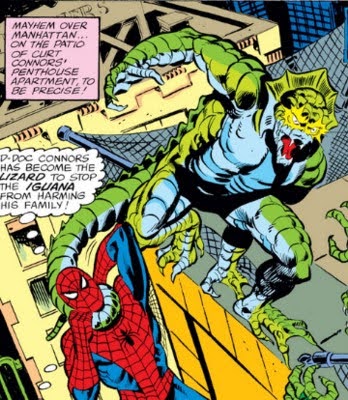
Robert Dunakin ‘26 / Emtertainment Monthly Staff Writer
Over the course of Spider-Man’s more than sixty year history, readers have been introduced to an almost unrivaled progression of iconic villains. Yet, by this same token, within a nearly sixty year history, some duds are requisite. After nearly a thousand issues of The Amazing Spider-Man—and well over that number when you factor in titles like The Spectacular Spider-Man, Web of Spider-Man, and Marvel Team-Up—the well starts to run dry. Sometimes, this means writers resort to joke villains, characters like White Rabbit or the Spot who were never meant to be taken seriously. In other moments, they’ll try too hard to tie into the zeitgeist, giving birth to bizarre, of-the-moment time capsules like Hypno-Hustler. Villains like these are the Morbius movie of the comic book world, the entertaining, laughable kind of bad. But in celebration of the Madame Web movie’s stunningly poor reception, its reviled status as a film not even worthy of reverence as “so-bad-it’s-good,” this list intends to pay tribute to the so-bad-it’s-bad of the comic book world, the villains so lame that don’t even earn derision.
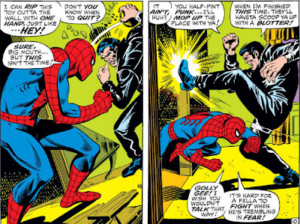
Man Mountain Marko: Spider-Man sure fought a lot of mobsters in his day. Starting with the introduction of the Enforcers in issue #10, Spidey spent almost a quarter of his silver age days—just shy of twenty issues—up against organized crime. At best, this led to the introduction of iconic characters like Kingpin or Silvermane. At worst, you have Silvermane’s principle henchman, Man Mountain Marko. Starting with Marko’s uninspired name, it becomes evident there just isn’t much to this character. He doesn’t have a look or a gimmick, especially when compared to later, more successful villains like Hammerhead or Tombstone. Even the aforementioned perennial also-rans, the Enforcers, had distinguishing features. Marko is just … slightly stronger than the average person.
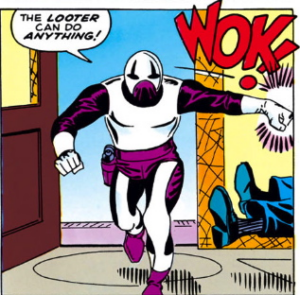
Ditko, Steve. The Amazing Spider-Man #36. Earth’s Mightiest Blog, https://earthsmightiestblog.com/character/looter/. Accessed 5 March, 2024.
Meteor/Looter/Meteor-Man: It’s almost never a good sign when the writers can’t even decide on a name for a character. Introduced at the tail-end of Steve Ditko’s time on The Amazing Spider-Man, Meteor is a man called Norton Fester who gains super-human strength and agility by huffing meteor fumes. By this point working on the title, Ditko was ready to quit, and in characters like Meteor, it shows. Meteor is one of several Z-list villains to debut in the final ten issues of Ditko’s run, joined by such luminaries as “A Guy Named Joe,” Robot-Master, and the Cat. Meteor earns distinguishing marks for later writers’ efforts to rehabilitate him, starting with a stint as “Meteor-Man” in Marvel Team-Up, and continuing into the present, where he’s made sporadic appearances in the mainline Amazing Spider-Man title.
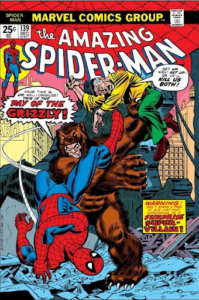
Grizzly: There is a strange, unpredictable alchemy to what animals do or do not work well as the basis for comic book characters. On paper, Grizzly is no sillier than many other Spider-Man bad guys—Vulture, Chameleon, Rhino. Rhino especially bears comparison. Bears are, after all, fearsome apex predators. There’s even another Marvel character—Ursa Major—who manages to make almost exactly the same gimmick work, introduced nearly a decade after Grizzly. Something magic happens to make Grizzly ridiculous. Maybe it comes down to his introductory battle with Spider-Man, in which Spidey defeats Grizzly by pulling his costume apart with webs, leaving the ursine menace powerless. Maybe the problem really is as simple as how silly it is that Grizzly is a guy with his head poking through the mouth of a bear costume.
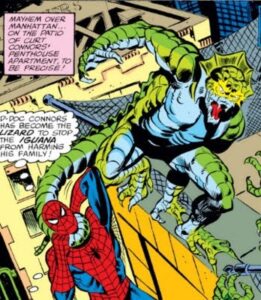
Iguana: Lizard, but without any of the complexity that makes Lizard worthwhile. Some of the worst offenders on this list are characters who are just worse copies of existing bad guys. Iguana is especially egregious because his origin even involves Lizard. First appearing in the pages of The Spectacular Spider-Man #32, Iguana is the mutated pet iguana—named “Mooney” in reference to Marvel Comics penciler Jim Mooney—of doctor Curt Connors, the Lizard. At the end of this initial storyline, Iguana is depowered and seemingly destroyed, only to return years later without explanation, ultimately being killed by Kraven in a bloated crossover storyline. Throughout his appearances, Iguana manages to perfectly capture the flaws of multiple Spider-Man eras. In his origin, Iguana reflects the struggle of bronze age comic creators to navigate the increasingly complex lore of the Marvel universe, tempering a desire to introduce new characters while enhancing existing ones. In the modern era, Iguana embodies the desire to emulate and reference past comics without really understanding them—or even pulling open the Marvel Wiki.
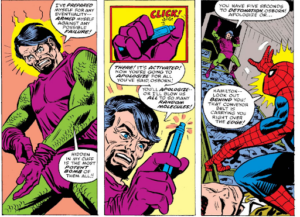
Green Goblin: Not, not Norman Osborn. Or Harry Osborn. Bart Hamilton. Dr. Barton Hamilton was Harry Osborn’s therapist, who learned while Harry was under hypnosis of Harry’s previous experiences as the Green Goblin. Using Harry to uncover a hidden cache of Green Goblin’s equipment, Hamilton became the new Green Goblin, so that he could … be Green Goblin. Hamilton’s motives are never expanded on, outside of a brief text blurb about “a sense of power” that came with trying on the costume. The character ultimately amounted to an editorial mandate, a nothingburger thrown out by the writer to get a Green Goblin story on the stands. Spider-Man’s unmasking of Hamilton as Green Goblin comes without any of the tension or pathos of either Osborn’s reveal as the super-villain, instead feeling like the climax to an episode of Scooby-Doo.
It has been said that a hero is only as good as his villain. In Spider-Man’s case, the strength of his rogue’s gallery is a testament to his versatility. But it’s flukes like Iguana and Grizzly that serve as the best reminder of what makes Spider-Man comics so unique: Spidey. The character has held on through deals with the devil, neogenic nightmares, and even Nick Lowe’s tenure as editor. All of these baffling characters have their fans, because to someone, they represent Spider-Man. This is, perhaps, at the heart of why Sony’s Spider-Man Universe— the “SSU” for short, far less funny than its original “Sony Universe of Marvel Characters,” or “SUMC”— doesn’t work: a “Spider-Man Universe” doesn’t work without Spider-Man to hold it together. And as Sony continues to scrape the bottom of the barrel for characters to spotlight instead, look to this list for a reminder that it could always be worse.